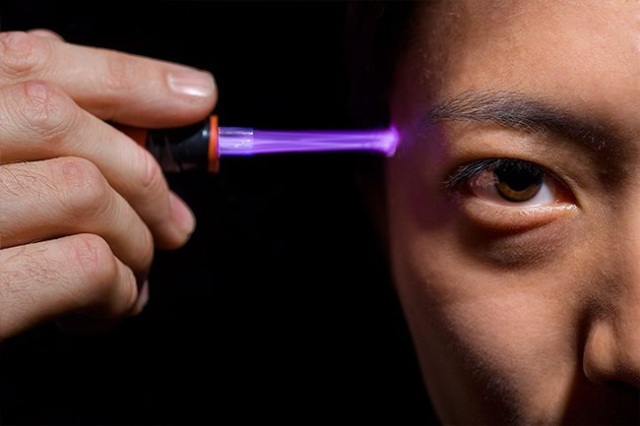 |
 |
About Us
A Brief History of the Plasma Engineering and Diagnostics Laboratory
The Plasma Engineering and Diagnostics Laboratory was started in January of 2009 with the arrival at Texas A&M of Dr. David Staack. At TAMU PEDL Laboratory we investigate novel plasmas and application in the high density regime of low-temperature plasmas (the grey area to the right of low-temperature plasmas in the figures below). Our goal is to enhance education and research in the multidisciplinary field of plasma engineering. We seek funding from government agencies such as: the department of energy (DOE), NASA, the National Science Foundation (NSF), and the department of defense; to pursue this research. We have several patent pending technologies in this area and collaborate with large and small industries to further develop technologies to benefit society. From the educational perspective we seek to increase public awareness about the role of scientific research in improving our lives. In the university setting we hope to provide industries with well trained professional and to increase the number of students (especially domestic and underrepresented groups) pursuing advanced degrees in this noble profession. |
Recent Graduate Dr. Cliff Tsai giving a lab tour. |
The Facilities
The Plasma Engineering and Diagnostics Laboratory in 2014 moved to a 3000 sq. ft. laboratory at the University Services Building. The lab has various equpiment and is well suited for the microscopic and spectroscopic investigation of plasma discharges in liquids, inert and reacting gases from high pressure to vacuum conditions. These facilities are used for several projects ranging from the investigation of high energy density micro-plasmas in liquids, to biomedical plasmas, to thin film deposition to, the non-equilibrium chemistry of crude oil reforming. Specific equipment are: a one meter focal length scanning monochromator for high resolution spectroscopy; a dedicated inverted fluorescence microscope and stereo microscope for microscale plasma and tissue visualization; a ultrafast (200 ps) gated ICCD camera for the highest temporal resolution imaging and spectroscopy; a high frame rate (300kfps) CMOS camera; two gas chromatographs capable of oil and hydrocarbon and combustion product analysis; exhaust and chemical hood; a 160 sqft portable walk-in fume hood; custom nanosecond pulse generator capable of mJ to J per; several RF, DC, and microwave power supplies for the generation of various dielectric barrier discharges (DBD), capacitively coupled plasmas (CCP), microplasmas, discharges in liquids, and plasma jets; a 2 GHz oscilloscope with high bandwidth voltage, current, and dI/dt probes; schlierin visualization system and optics; and several discharge chamber ranging in operating pressure from 0.01 millitorr to 100 atmospheres. |
Dr. Staack's hand, and no it doesn't hurt. |
Plasma and their Applications
Plasma Research: Plasmas seem simple enough. They’re a collection of free electrons and ions governed largely by physical laws known to late 19th-century physicists. Yet the sophisticated and often mysterious behavior of plasmas is anything but simple. This is strikingly evident in, for instance, the dramatic images of solar flares—sudden plasma eruptions from the surface of the Sun. Plasmas are found almost everywhere both on Earth and in space; indeed only the invisible dark matter is more abundant. The vast regions between galaxies in galaxy clusters are filled with hot magnetized plasmas. Stars are dense plasmas heated by fusion reactions. Computer processors are fabricated using cold chemically reacting plasmas. Powerful lasers make relativistic plasmas in laboratories. Even common fluorescent lights are filled with efficient plasmas. And the enormously varied list goes on. None of these plasmas are quiescent; they wriggle and shake with instabilities and turbulence, and sometimes they erupt with spectacular force |
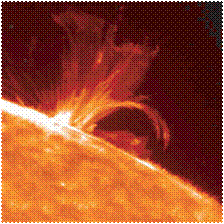 |
There is a bewildering variety and complexity of plasmas. The figures below show two depictions of various traditional areas of plasma research (in white) and new areas of study since 1990 indicated in gray. The density of charged particles is indicated on the horizontal axis. and the temperature (both in kelvin and electron volts) is indicated on the vertical axis. The units of eV are used by engineers and physicists in this area because plasmas can be incredibly hot (one eV is about 10,000 K). Research areas are general grouped into 5 thrust areas of plasma science and application:
1. Low-temperature plasma science and engineering
2. High-energy-density (HED) plasma science
3. Magnetic fusion plasma science
4. Space and astrophysical plasmas
5. Basic plasma scienc
Here at TAMU we are pushing the boundaries of low temperature plasmas to higher densities by investigating microscale plasmas, pulsed power devices and discharges in
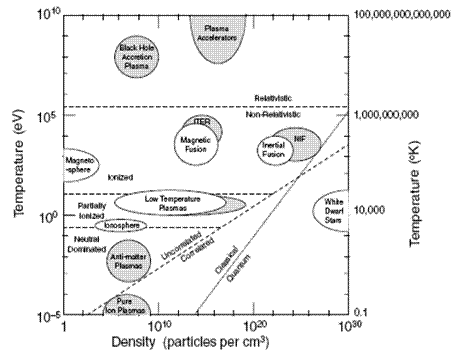 |
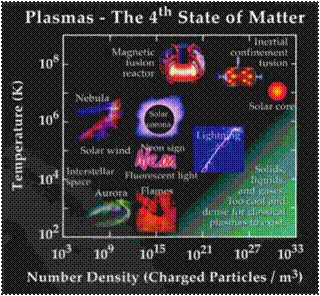 |
How do Plasmas affect you?
Well obviously, the sun (a very hot and dense plasma) greatly affects our lives but it has done so even when we were ignorant of its nature. Plasmas and the technologies they enable are also pervasive in our everyday life. The picture below " Plasmas in the kitchen" illustrates some technologies familiar to use. Each one of us touches or is touched by plasma-enabled technologies every day. Products from microelectronics, large-area displays, lighting, packaging, and solar cells to jet engine turbine blades and biocompatible human implants either directly use or are manufactured with, and in many cases would not exist without, plasmas. The result is a better quality of life and economic competitiveness
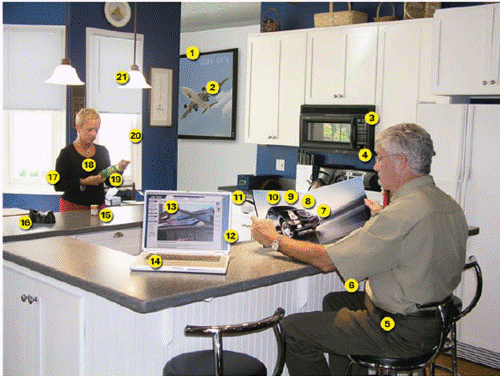
| 1 - Plasma TV | 8- Plasma produced hydrogren in a fuel cell | 15 - Plasma sterilization in pharmaceutical production |
| 2 - Plasma-coated jet turbine blades | 9 - Plasma particulate filter in muffler | 16 - Plasma treated polymers |
| 3 - Magnetron plasma source emits microwaves | 10 - Plasma aided combustion in engine | 17 - Plasma treated textiles |
| 4 - Diamond like plasma chemical vapor deposition eyeglass coatings | 11 - Plasma ozone water purification |
18 - Plasma treated heart stent |
| 5 - Plasma ion-implanted artificial hip | 12 - Plasma deposited LED display panel | 19 - Plasma deposited diffusion barriers for containers |
| 6 - Plasma laser cut cloth | 13 - Plasma fabricated silicon solar cells | 20 - Plasma sputtered window glazing |
| 7 - Plasma high intensity discharge lamps | 14 - Plasma processed microelectronics | 21 - Compact fluorescent plasma lamp |
